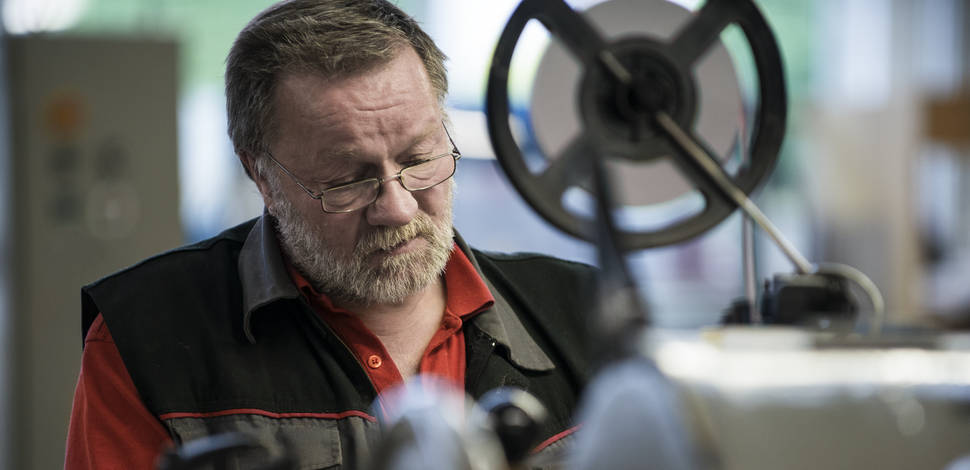
Our papers are extremely versatile and they have to be as their properties have to meet a big number of requirements. Here, you will find noteworthy information on manufacturing techniques, quality characteristics, quality management and testing procedures. Please just click on one of the following headlines.
Production on the foudrinier machine
Production of paper on a continuous-wire Fourdrinier machine starts with the discharge of a highly diluted mixture of pulp and water onto the machine. The papermaking stock is evenly distributed on the flat, plastic wire which continuously rotates around a series of supporting rolls and guiding rails. In addition to their support function, these rolls and guiding rails are also used to drain the water from the mixture of pulp and water.
Two-thirds of the way along the the wire section, the slurry is so drained of water and compact that the fibres will no longer shift. Further water extraction is only possible with flat suction boxes which build up vacuum. A so-called dandy roll is applied and lightly pressed down to make the paper surface more equal. It is also used, for example, to apply the ribbed structure typical of Hahnemühle FineArt paper.
The wire section is directly followed by the press section, which is the last element of the wet part of the paper machine. Two hydraulically loaded pairs of rolls and an optionally utilized third press are used to press out the remaining water from the endless paper web. The continuously rotating felt is used to transfer the web and remove water. Felts, some of which are still made of wool and others of a mixture of wool and synthetic fibres, have an exceptional capability to make different, characteristic marks.
The moisture remaining in the paper web is removed by contact drying with 16 steam-heated metal drying cylinders. To enhance this process the felt is pressed against the cylinder surface and hot air is blown in through air nozzles. The paper web is dried carefully at a temperature gradually increasing from about 70° C at the first cylinder to about 120° C at the end of the dryer section. In order to quickly expand the paper, the temperature is abruptly lowered at the cooling cylinders located immediately after the dryer section. The web can optionally be passed through a calender stock.
A re-moisturizer, in combination with a continuously operating measuring system, permits the paper moisture to be monitored and improved before it is rolled.
The paper machine works in a shift system five days a week at a speed of up to 105 m/min. The maximum width of the paper web is about 130 cm.
The bulk of production is neutral-sized paper which is subsequently processed to obtain high quality inkjet papers, and high quality natural papers designed for various painting and printing techniques. Different types of filter paper are also produced for numerous applications in laboratory analyses, medicine and quality control. The third group of papers is industrial papers developed and produced to individual customer specifications.
Production on the cylinder mould paper machine
Traditional paper production on a cylinder mould paper machine starts in the vat housing a mould, that is a stainless steel box in which a cylinder mould up to 260 cm in circumference and 130 cm in width is placed. The size of the cylinder is the chief factor in determining the size of the paper produced. Hahnemühle FineArt uses moulds of different structure to make velin or ribbed paper, with or without watermark. Hahnemühle has 15 cylinder moulds.
A highly diluted mixture of pulp and water is fed into the vat with combined uniflow and contraflow forming a fibrous web on the cylinder mould.
The sheet is transferred to the wet end of the machine with a suction roll located at the highest point of the cylinder mould.
Not only does the cylinder mould produce genuine watermarks, the paper sheet can also be divided into smaller sheets. For this purpose, special bands and metal dividers are attached to the surface of the cylinder mould with copper wire to mark the size of individual sheets. Thus the mould-made paper produced on a machine can have four ragged, or deckled, edges characteristic of hand-made paper. Some paper fibers gather on the attached deckle frames.
As the speed of the machine can be controlled, after the press section, the still wet paper can be torn along the marked, weaker lines. Only a sheet edge thus obtained can be treated as a deckle edge characteristic of mould-made paper.
The cylinder mould paper machine is not only used to make paper sheets, but also to produce paper rolls.
The double wet press section consists of a pair of [1mm] hydraulically loaded rolls connected with a parallel drive and a common top and bottom felt.
To improve water extraction, the paper web is then gently heated with an
infra-red dryer and introduced to the dryer section which consists of a series
of steam-heated cylinders. Thanks to special felt material used in the first
dryer group, paper does not come into direct contact with the cylinder surface and thus maintains good surface uniformity on both sides.
With a working width of about 126 cm, the machine has a relatively low speed
of 4-15 m/min, but this is necessary to insure a high quality end product.
A broad range of base weight from 80 to 350 gsm allows for the production
of diverse paper grades within the Hahnemühle FineArt GmbH product line.
Quality criteria
Due to the application purpose each paper has to meet special requriments. Click on one the headlines and learn what our papers make to become unique
